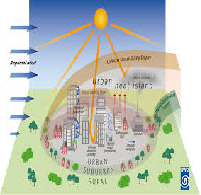Urban Heat Effect and Energy Consumption in Residential Buildings Urban heat island effect and energy consumption in residential buildings

Urban Heat Effect and Energy Consumption
Write about urban heat island effect and its impact on energy consumption especially in UAE and what methodology was used to tackle this effect and what were the recommendations.
Urban Heat Effect and Energy Consumption Recommendations
This study focuses on the urban heat island (UHI) development and its impact on household energy consumption. Hourly air temperature data were used to study the characteristics and intensities of UHI in the Bangkok area. A survey questionnaire of 400 randomly selected respondents is conducted to explain the relationship between UHI intensity and household energy consumption. Cities are dissipative structures. As such, cities generate heat, a phenomenon known as urban heat island (UHI). Even though the UHI is one of the most relevant effects of urbanization on urban climate, up-to-date methodologies to include it in the estimation of buildings’ energy consumption are still scarce.
Urban Heat Effect and Energy Consumption Research Methods
During the last 30 years, different methods and software have been developed to measure a thermal building’s demand. Building performance simulation is commonly used to calculate heating and cooling demand. However, such techniques do not adequately include the urban heat island effect, which could have an extreme impact on a building’s energy consumption. In fact, building operation is doubly connected with the urban environment: on the one hand, buildings generate heat that warms up the environment, and on the other hand, the urban environment alters building performance by the influence of UHI.
Urban Heat Effect and Energy Consumption
In this paper, a methodology to incorporate the UHI effect in building performance simulation is proposed. Urban weather data were downscaled at the urban morphology building level to estimate the cooling demand for different types of residential buildings. The global energy penalty for the whole residential building stock was estimated in four South American Pacific coastal cities.




